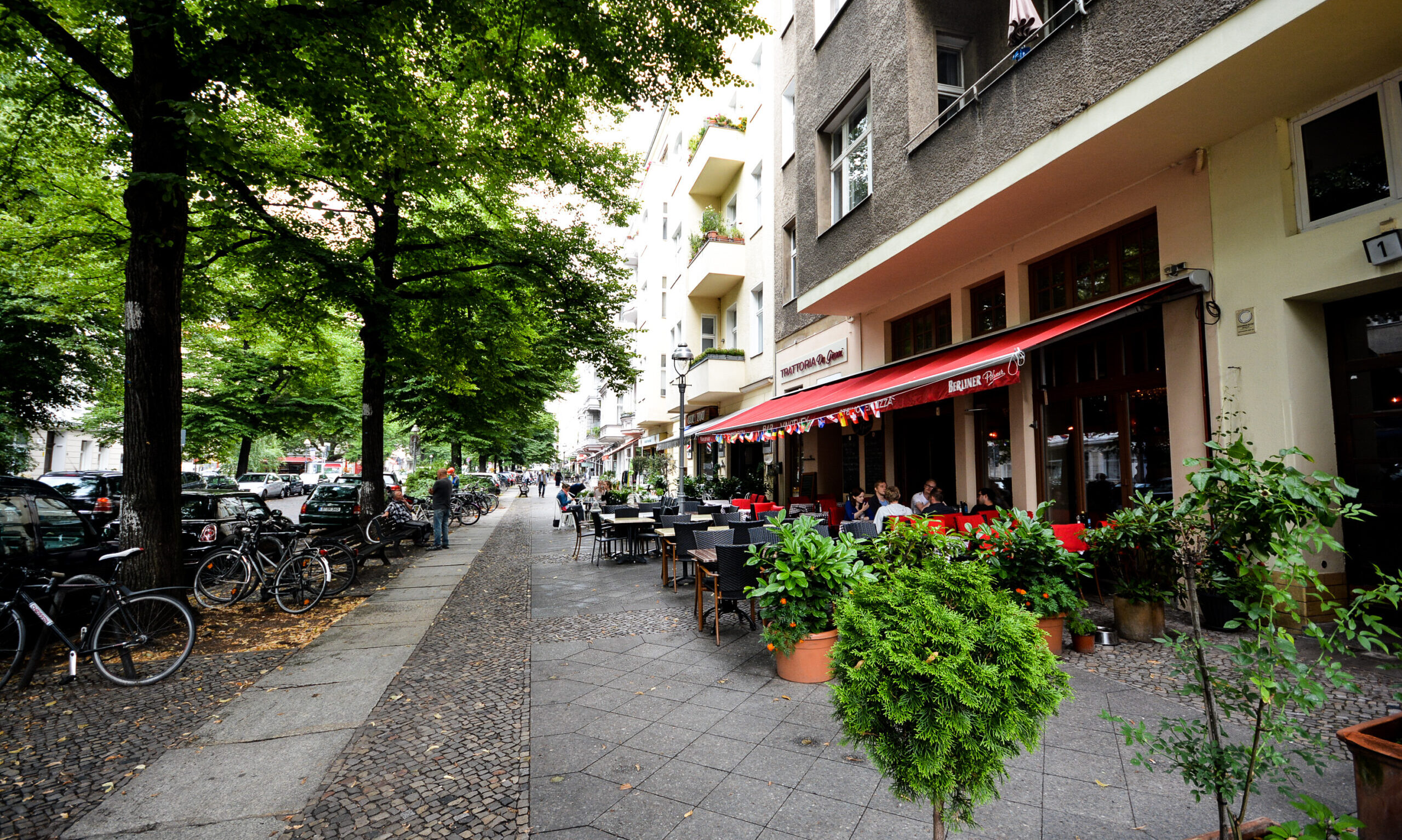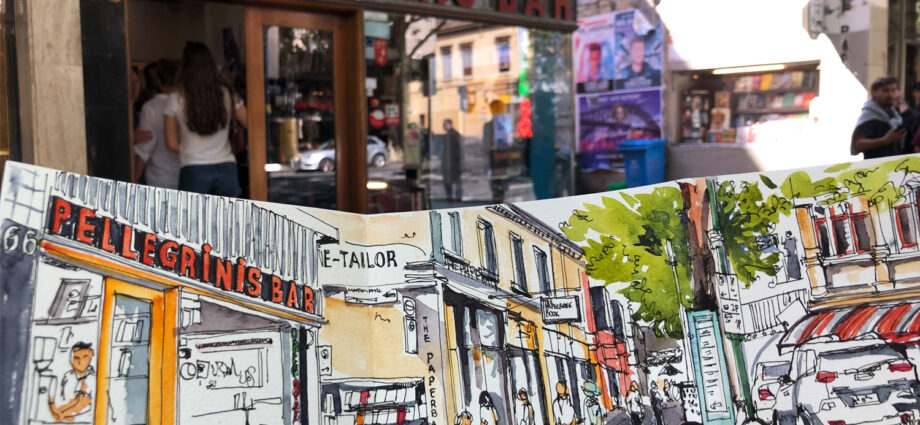“In January 2019 I started a long-term personal project to draw every building in the two-kilometre street – even the ugly ones. I see it as preserving the history of the community, sketching in the street & chatting to locals as I do. Over time I have been joined by a small gaggle of other artists & we make a regular day of sketching, lunching and chatting. It’s just wonderful when you find your ‘peeps’, & this project has literally drawn us together.“
-Helen wilding
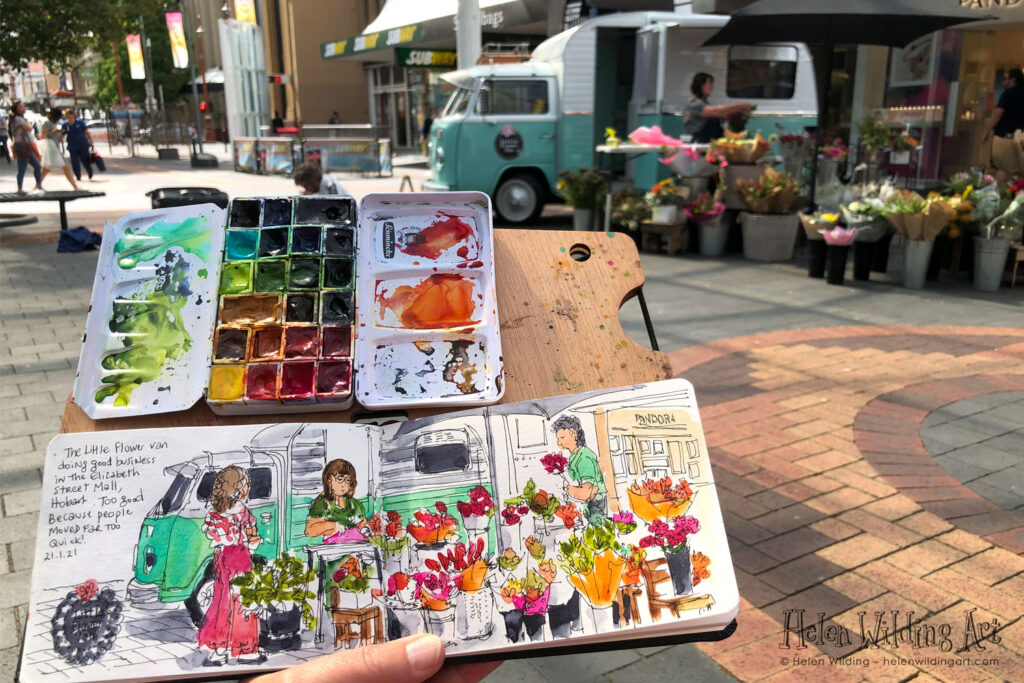
We love art at Pedestrian Space and often dedicate Fridays to featuring an artist whose work often depicts scenes of urbanism.
This Friday we feature Melbourne-based artist Helen Wilding whose vivid and colorful depictions of neighborhood and city life we were immediately drawn to.
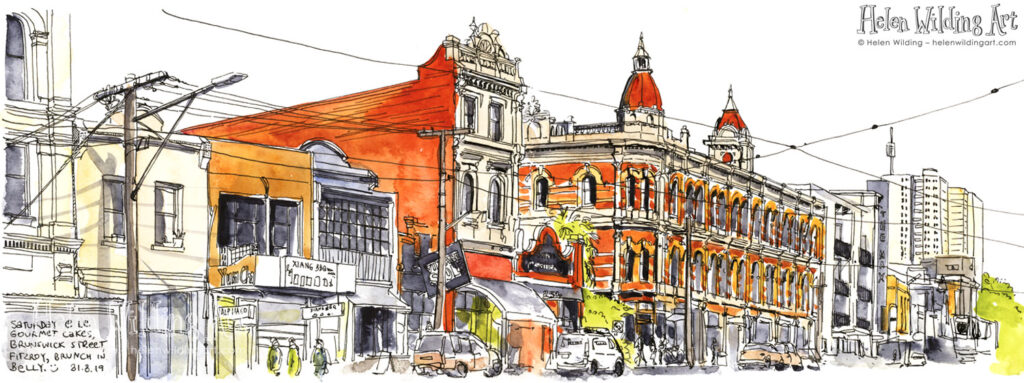
Helen is an urban sketcher, artist and medical research librarian. “It may sound like an odd combination,” Helen notes, “but I feel very lucky to have interests that exercise the different parts of my brain. I figure that something new is always around the corner – literally in the case of sketching on location!“
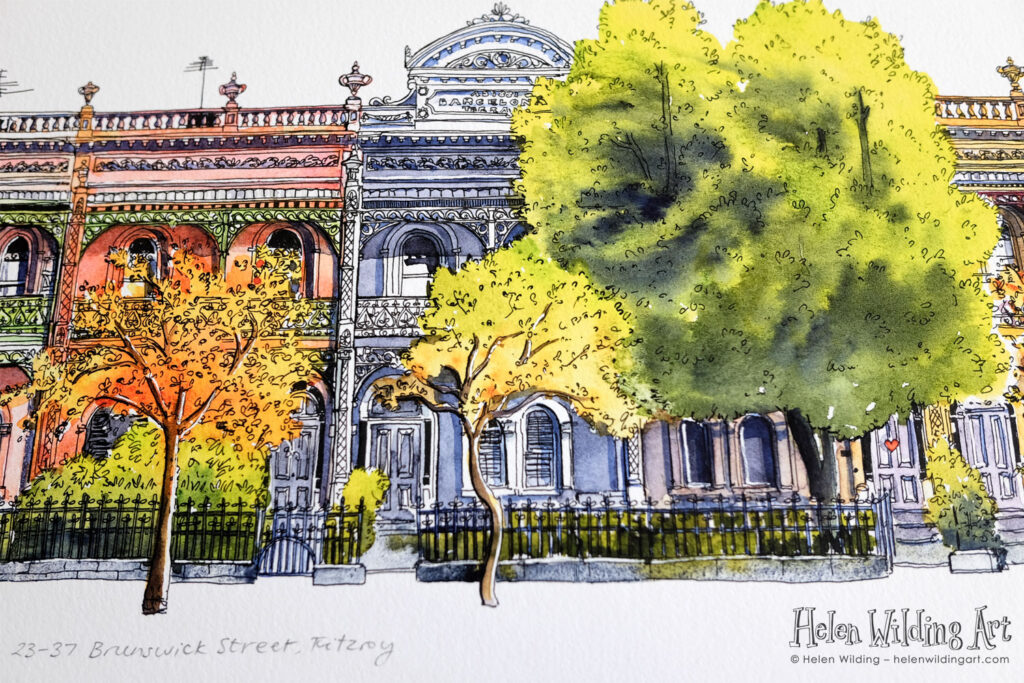
Pedestrian Space: Does your city or town of residence inspire your work?
Helen: Having lived on four continents I can honestly say that although I loved my time overseas, I feel incredibly fortunate to call Melbourne home. It’s a beautiful and extremely liveable city with a multicultural community that adds a lot of taste and flavour (literally)!
For a long time, I have to admit that I took my hometown for granted. It was traveling overseas that opened my eyes to urban sketching. After one trip I started to see Melbourne with fresh eyes, soaking up the details passing by on the tram and itching to pick up a fresh sketchbook. I joined the Melbourne Urban Sketchers and I have never looked back.

Although the area has a very long indigenous history, Melbourne only officially became a town in 1842. Many of the grand (and not so grand) buildings date from the late 1800s when prospectors came looking for gold. The Victorian architecture is great fun to draw, with its intricate decorative elements, iron lace, huge curved windows, and the odd finial on the roof – odd because they tend to fall off over the years! I really enjoy exploring details that add texture and interest to a sketch or painting, and those details are often what tell the story of a place. It could be peeling paint, posters on the walls, a broken pediment, or half a bike locked to a fence. There is a lot of fun in imperfection and the contrast between beauty and ugliness.
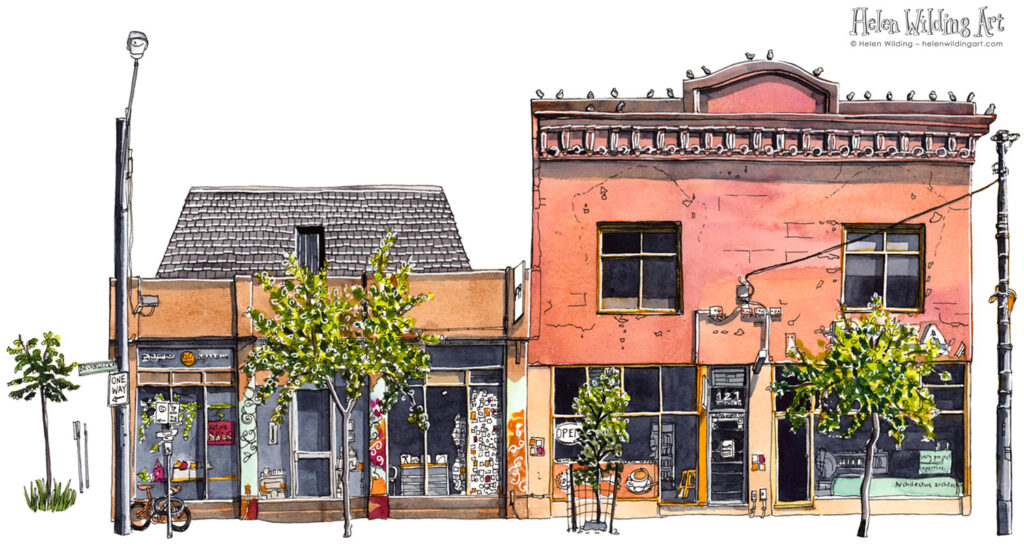
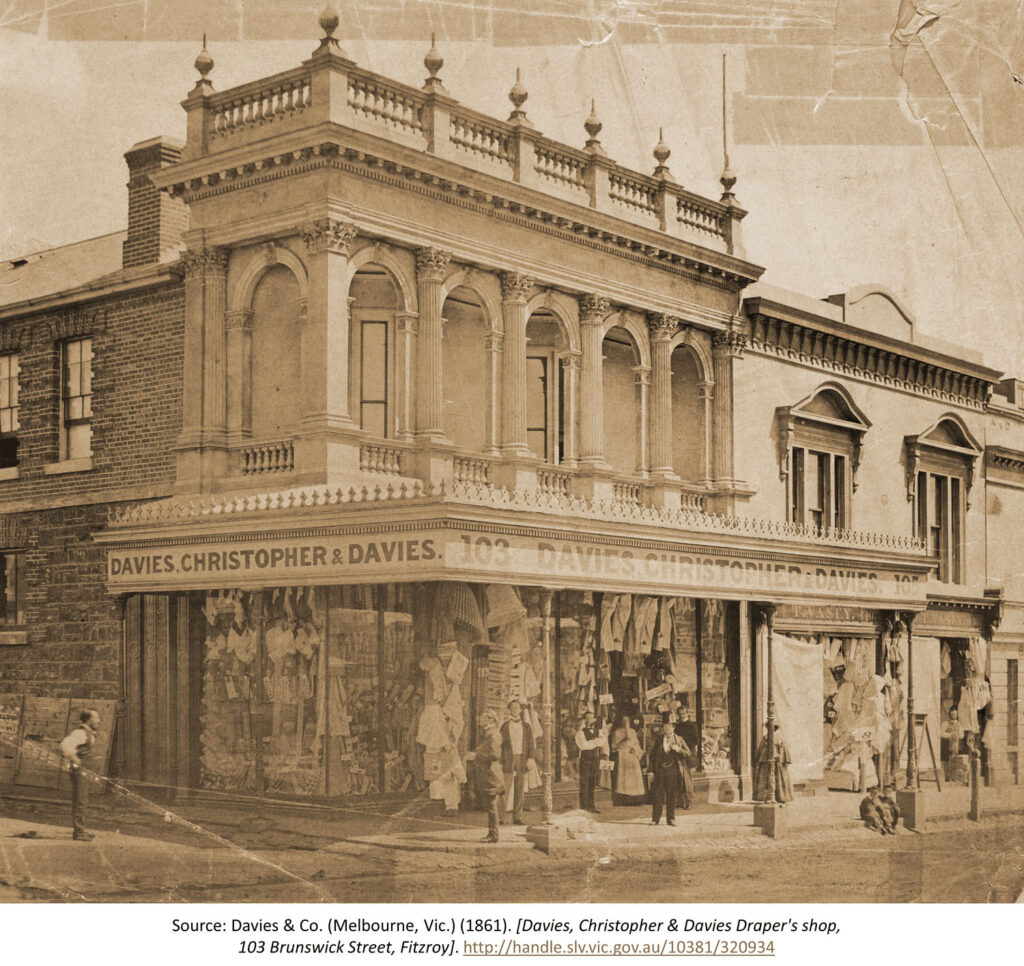
I was born in Australia but spent most of my childhood overseas. Dad loved to introduce us to different cultures and amazing places, and I think that was a wonderful gift. Living in different countries made me appreciate and seek out what locals love about their hometown rather than just visiting the tourist hotspots. I would much prefer to sit in a back street sketching a flower seller than queue to see something everyone else has already seen and instagrammed.
I never finished my graphic design course at university, but that didn’t stop me from drawing or painting. Art has always been a part of my life and it has helped me through a lot of tough experiences. I have mostly learned through practice – especially with respect to urban sketching, which you can literally do anywhere.
I always carry a sketchbook because it is a wonderful way to remember almost any experience or place. I can look back at old drawings and remember exactly what was happening, who was talking to me, the sounds of passing traffic, and even the smells – which were hopefully good! Photos don’t have the same effect on me at all, perhaps because they are taken in a second whereas it takes time and concentration to sit and draw. My husband calls it “going analogue”.
-Helen Wilding
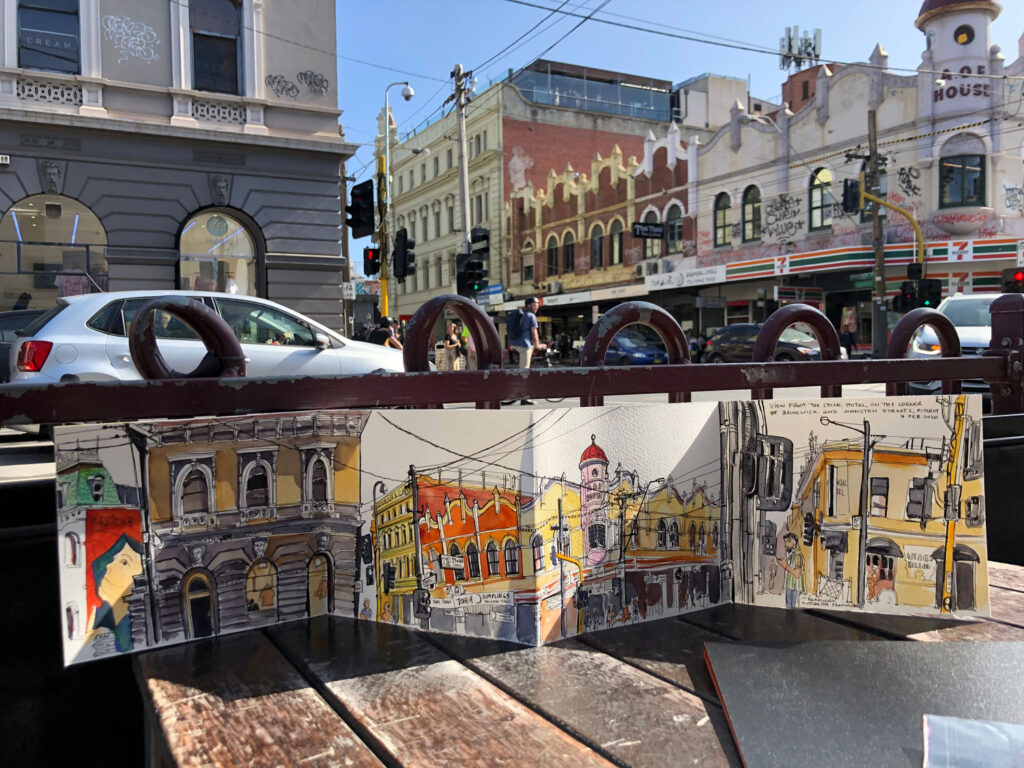
What is the relationship between the city and your art? Does urbanism influence your work?
I am definitely a city person. I admire the beauty of natural landscapes, but they don’t hold my attention for long. I love the built environment and the way it reflects the lives of the people who live and work there. Maybe it is because of my love for detail, exploring nooks and crannies, and finding joy in the quirky and unexpected. The urban environment, full of so many people, is packed with stories and history, which I often write about in my sketches.
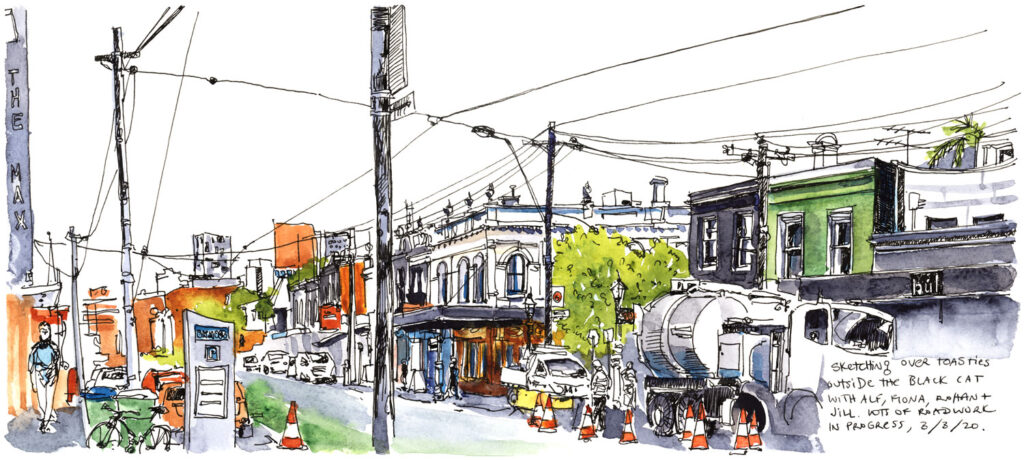
Wherever I am in the world, when I’m sitting in a city street drawing locals regularly come over to look and chat. I am quite shy, so it is lovely to meet people who I would never have spoken to otherwise. Sometimes these “conversations” happen in languages that I don’t understand at all, so we are reliant on gestures, pulling faces and pointing. It always ends with smiles and laughter!
The only thing about urban life that I really struggle with is graffiti – not as street art and murals (which I really like) but when it is just plain vandalism. I refuse to celebrate tagging by drawing it, and much as I am committed to capture everyday life, I try to highlight the beauty underneath instead. I suppose I am trying to find the fairy tale in the everyday.
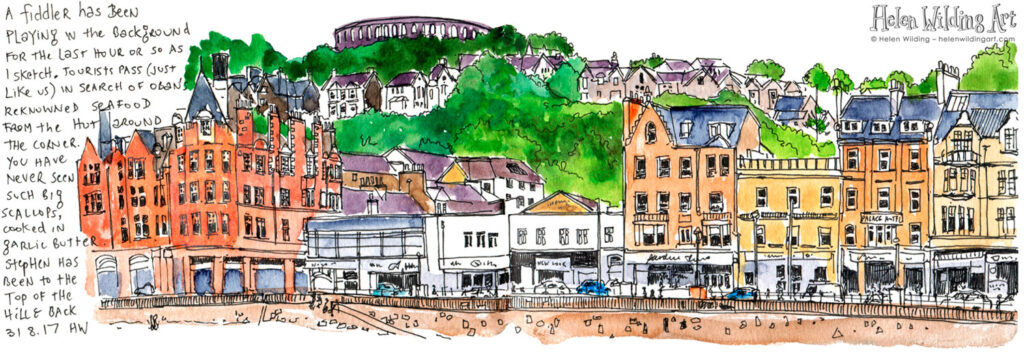
What mediums do you work with?
These days I mostly work in pen and watercolour. Working on location means that traveling light is really important, so I am always looking for the perfect kit to carry around with me. When travelling I usually carry a couple of small A5 Hahnemuhle watercolour books. It’s amazing what you can fit in them, and the watercolour stays nice and bright.
When I have more time I like to sketch on long sheets of folded Bockingford cold press paper. That lets me draw panoramas so I can include as much as possible. My aim is to draw the viewer into that moment with me, as if they too are turning their head from left to right, experiencing what is going on around them.
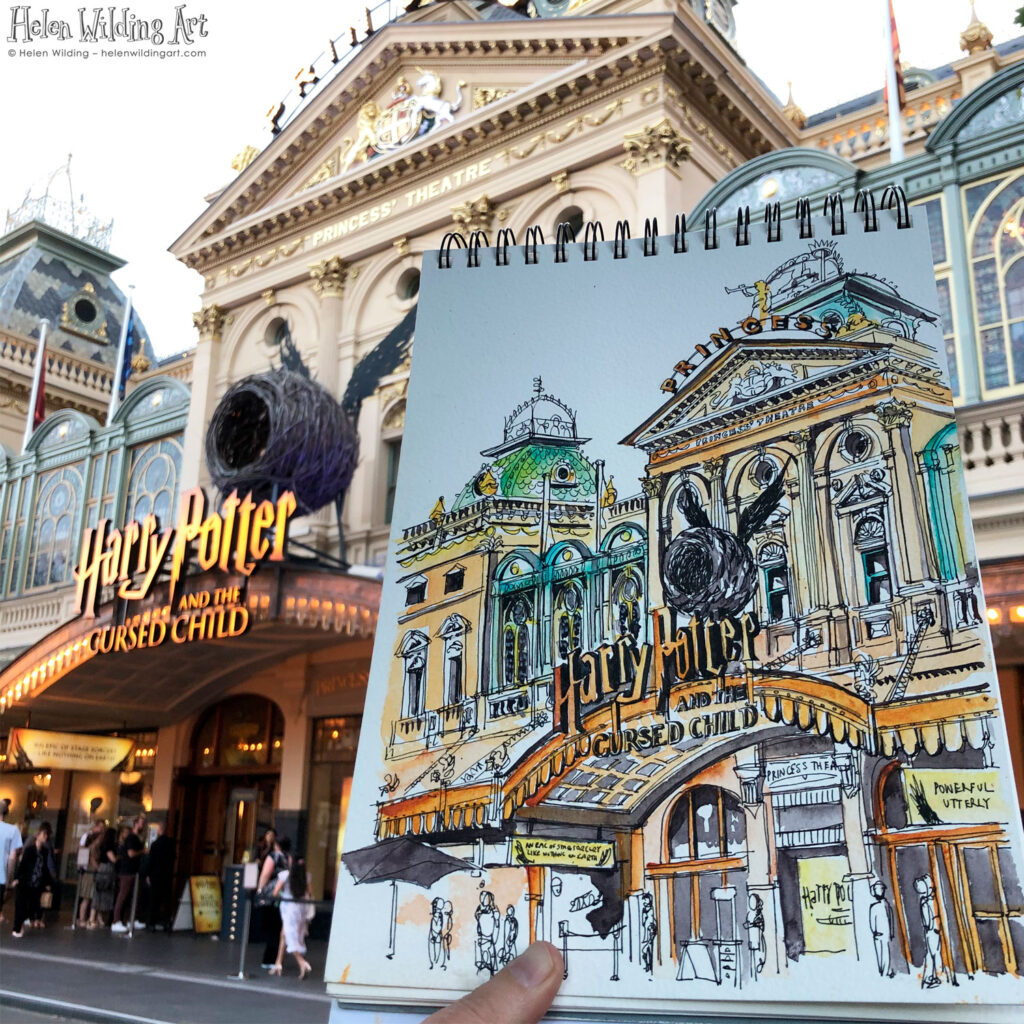
My favourite fountain pen at the moment is the TWSBI Eco which I fill with black waterproof De Atramentis archive ink. It can carry a lot of ink for marathon sketching sessions, and the nib runs smoothly on the long sheets of paper I balance on my lap as I draw.
I love rich, vibrant watercolours, so I play around with lots of different brands to find just the right brick orange and the perfect leaf green. It gives me a real thrill when I manage to make my work pop, or a texture surprises me, so I’m trying new colours and new brands all the time. Having said that, my favourites at the moment are Daniel Smith, Holbein and Schmincke.
I scan my work at home in my studio, and tidy it up to reproduce as prints. Although that means I spend a fair bit of time working in Adobe Photoshop, I never imagine myself shifting away from real pen and paper.
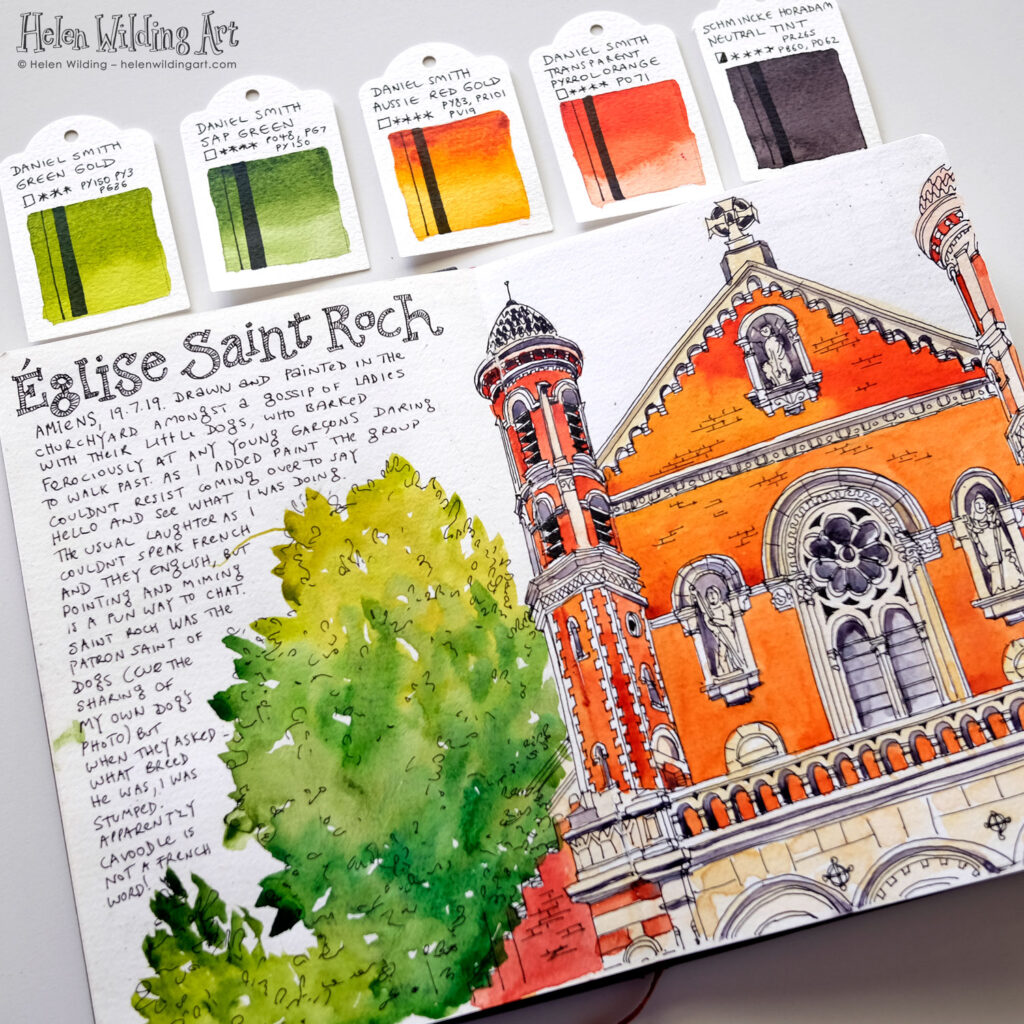
How do you move around the city and what is your favorite mode?
Trams are definitely my favourite mode of transport. Melbourne is famous for them, and it is easy for me to catch a tram in and out of town and the hospital I work at. Our tram route goes down Brunswick Street, so it is no coincidence that it has become my favourite place to draw. Melbourne is a city of wide pavements and lots of street shopping, so it is natural to walk as well.
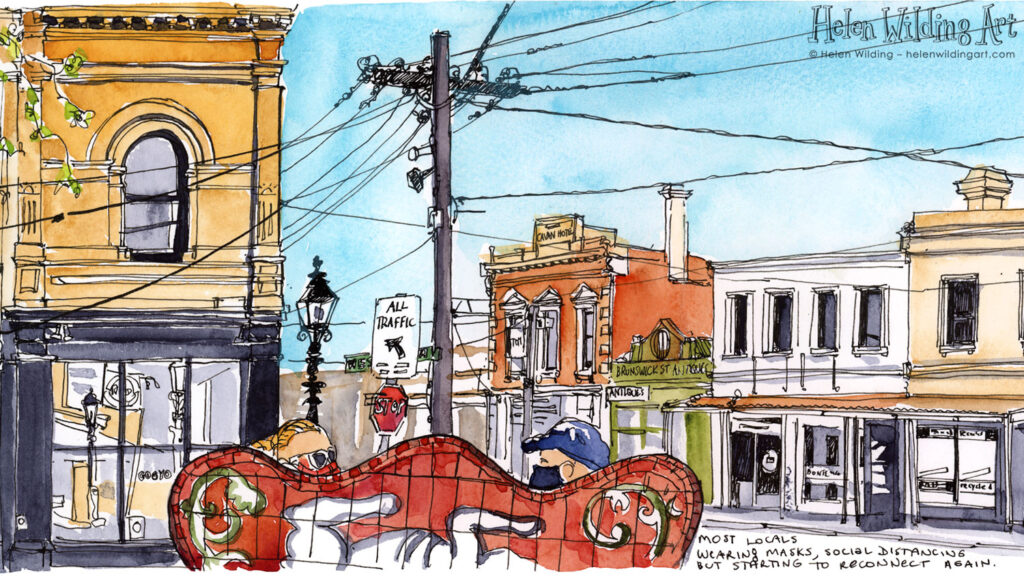
What is your favorite street or sidewalk space in your city of residence?
Brunswick Street, Fitzroy is my favourite place to draw. It is just north of the Melbourne city centre, and is full of sketching inspiration, local characters and lots of tempting cafes to refuel with tasty deliciousness.
In January 2019 I started a long-term personal project to draw every building in the two-kilometre street – even the ugly ones. I see it as preserving the history of the community, sketching in the street and chatting to locals as I do. Over time I have been joined by a small gaggle of other artists, and we make a regular day of sketching, lunching and chatting. It’s just wonderful when you find your ‘peeps’, and this project has literally drawn us together.
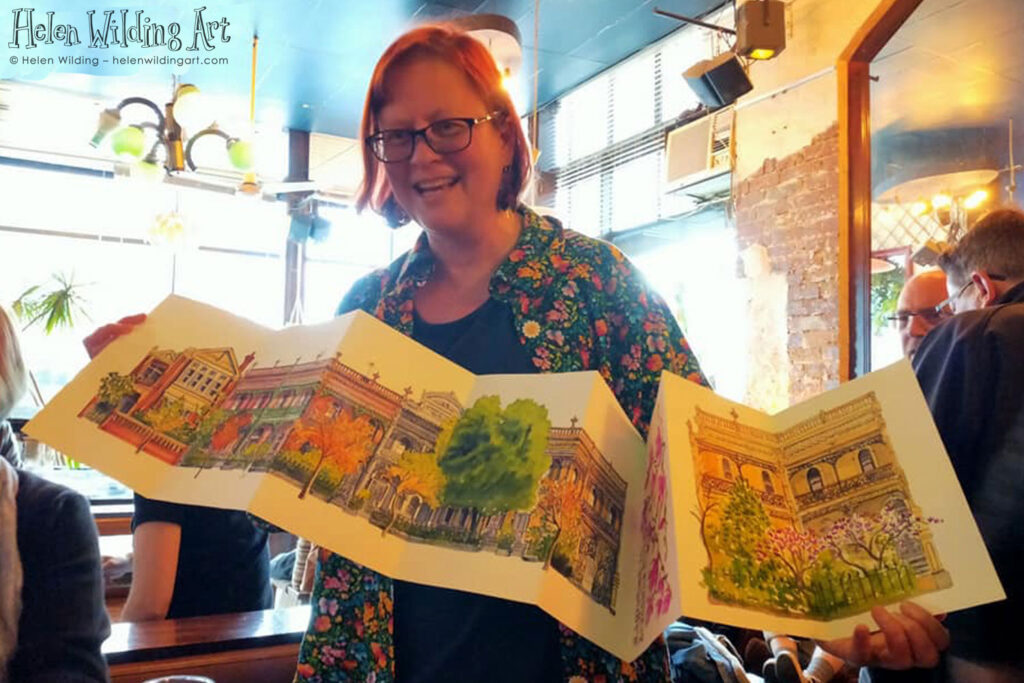
Brunswick Street has some really fine Victorian buildings from its early years, but it also went through several very disreputable stages where gorgeous buildings were pulled down, or in some cases, even blown up ‘by accident’! Being a librarian, I like to explore the local history of the area I’m drawing. Newspaper journalists of the 19th century loved to gossip and there are splendid stories about the questionable antics of the local population, many of whom would have convict backgrounds. It’s all free to discover at https://trove.nla.gov.au/ – courtesy of the National Library of Australia.
I remember drawing this incredibly ugly pink building in Brunswick Street, Fitzroy, and noticing shapely cracks above each window. The top of the building was quite ornate, as well as being the perfect landing place for a tidy line of pigeons. Obviously, there had been major changes over the years, but what had it originally looked like?
I searched Trove and found a picture of the same corner in much better times. Alas, the stunning double-storey Victorian shop on the corner had been pulled down, but you can easily recognise the ugly pink building in its 1861 glory.
Are there other pedestrian areas in your city you like to spend time in or appreciate?
Melbourne is a beautiful city, and I am constantly surprised at what I discover by simply looking up. I love to walk around the main streets and see what I can discover. Collins and Bourke Streets have some particularly beautiful Victorian buildings. Flinders Street Station is a Melbourne icon in the centre of town, and a popular place for visiting urban sketchers. I’m not that interested in modern architecture, but Federation Square is quirky and surprising, and it’s nice to sit at a bar along the Yarra River. The Bourke Street mall is always full of buskers, and you can find almost anything you can imagine at the Victoria Market, famous for its hot jam doughnuts. We have terrific museums, galleries and theatres, and events such as the Melbourne Comedy Festival, Moomba and White Night, although of course the pandemic has really impacted the arts in Melbourne.
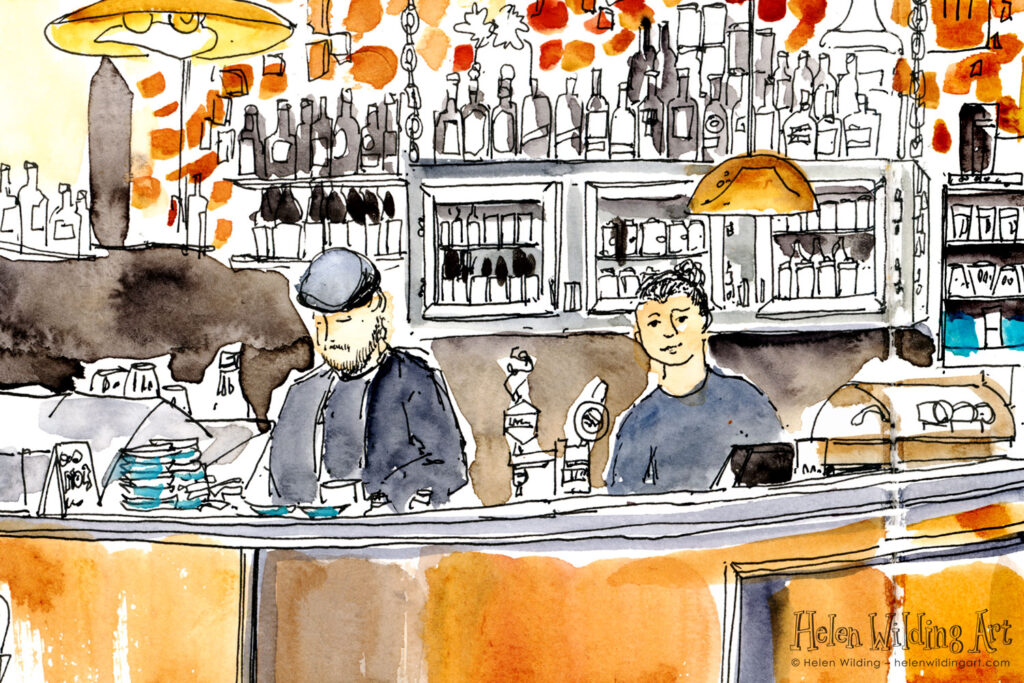
What challenges, as well as opportunities, do you see with issues of walkability in your city?
Melbourne has a compact city centre, but the greater Melbourne area is huge, covering nearly 10,000 square kilometres. That’s for a population of just over 5 million people. We tend to build out, rather than up, although the city centre is quickly filling with high rises which inevitably affect the character of the area. As you can imagine, the inner suburbs are better serviced by public transport and quite easy to get around without a car, but it becomes more difficult the further out you go.
I am lucky to live quite close to town, and our home is in easy walking distance of shops, schools, parks, restaurants and public transport routes to town. Most of the houses in our area were built in the 1920’s and every street has footpaths. Cars are now filling the streets, but they weren’t designed for that and parking is becoming a problem.
My husband rides his bike almost everywhere, but I think you need to be a confident rider to do that. Melbourne has very few bike paths, and bike lanes marked out on the main roads are often blocked by parked cars. Drivers don’t tend to look for bike riders so I personally don’t feel confident enough to ride – although that could just be laziness …
Over the last decade I have noticed a shift away from car ownership. When I was a teenager (a very long time ago) everyone got their driver’s license, but many young people in Melbourne no longer bother. There are alternatives that didn’t exist when I was growing up, such as Uber and car-sharing schemes. Bike paths, although not perfect, are increasing. Most streets throughout greater Melbourne are walkable, with footpaths bordered by a nature strip with grass and trees. We still have a lot of local street shops, so we are not dependent on big malls that you have to drive to. Public transport, although not perfect, is improving all the time, and there is a current push by the state government to get rid of dangerous level crossings and raise trains above roads. That helps to improve traffic flow, safety and create new green space underneath so that there are less divisions between neighbourhoods. I see all this as going in the right direction, with constant improvements in reliable and affordable public transport being key.
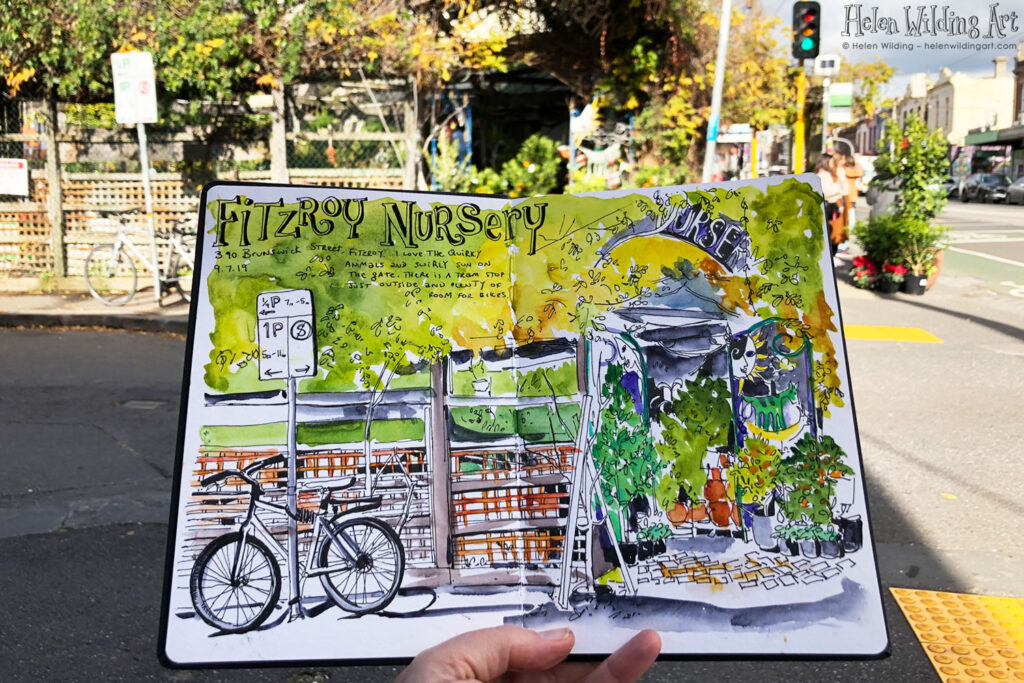
What are your thoughts about sustainable urbanism in local region?
I’m quite embarrassed about our federal government’s lack of commitment towards climate action and sustainability, but most of our state governments, including in Victoria, are committed to renewable energy targets and reducing emissions. Solar power is promoted and subsidised. The tram network has been linked to renewable energy. On a local level, there is an increased emphasis on recycling and reusing, including bans on plastic bags and compost collections. Bike riding is promoted, although that is quite a cultural shift and we have a way to go to make it safe. Public transport is improving. Sustainable communities are being created, including new residential developments near the city. We have a long way to go, but awareness of the need for sustainable urbanism is certainly increasing.
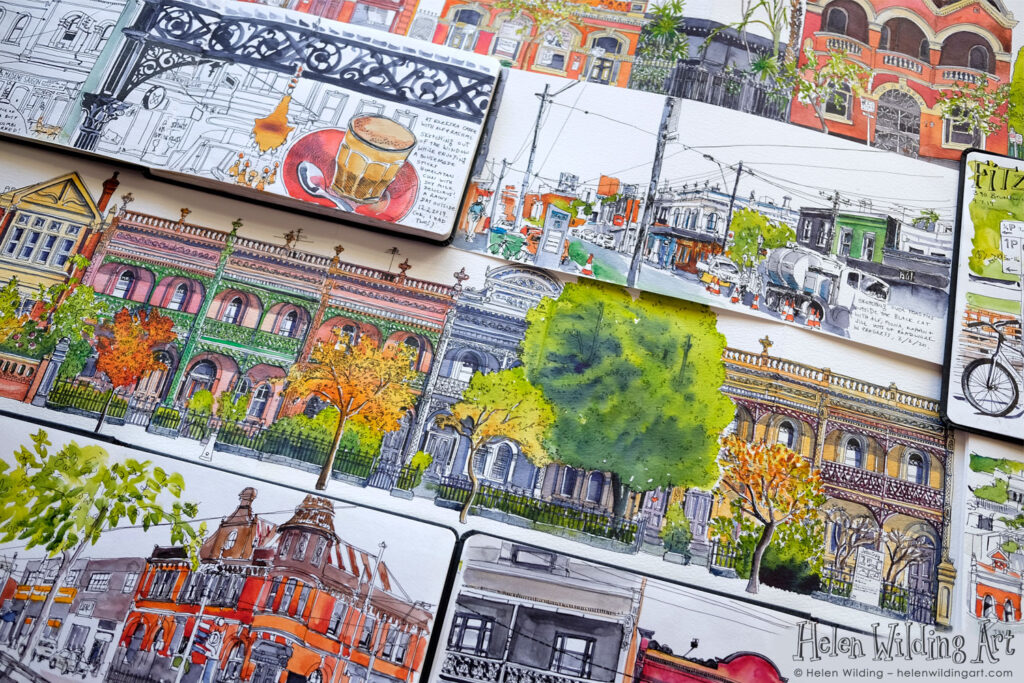
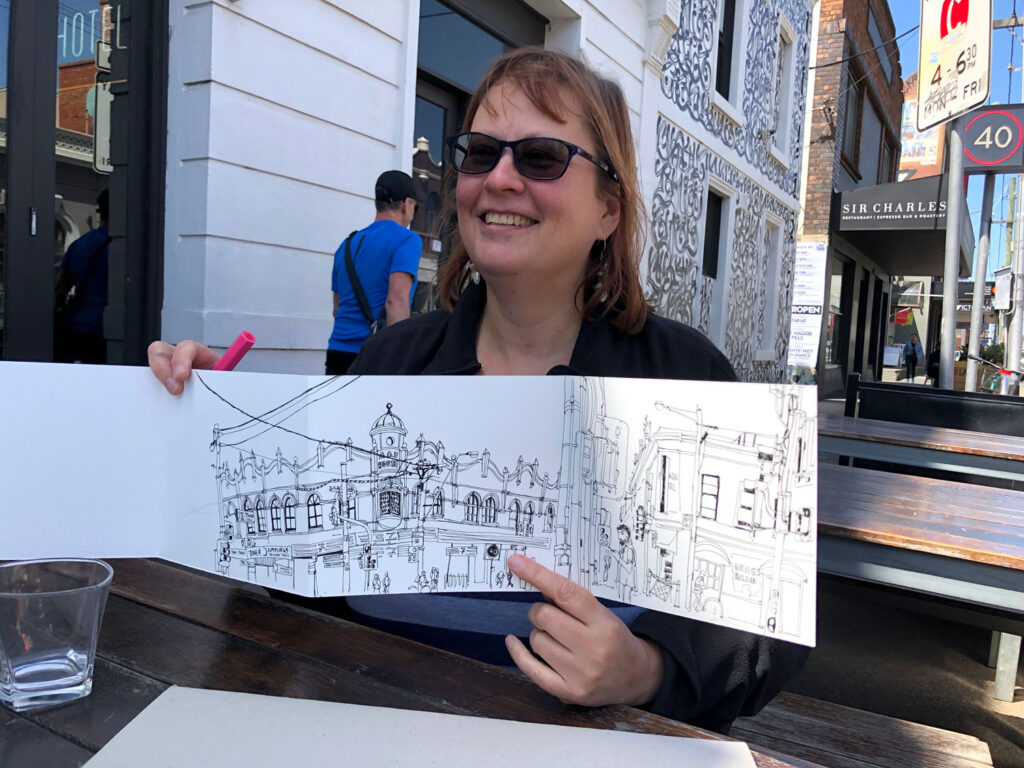
Visit Helen online at https://helenwildingart.com
